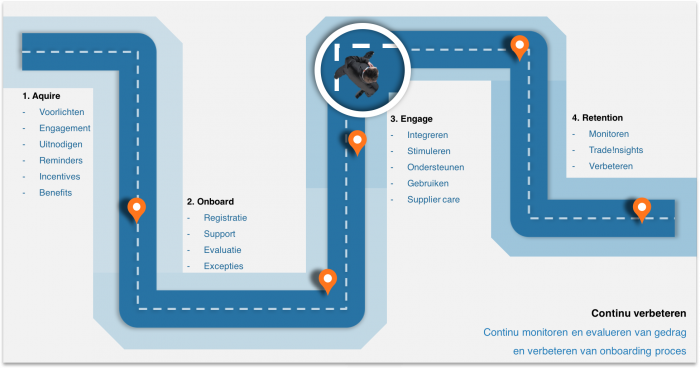The biggest challenge for e-invoicing today is not the technology, nor the standards, but supplier unboarding. If you have mastered supplier onboarding the chances of success become much greater.
It happens all too often that companies invest in a solution for exchanging invoices and/or orders electronically, but its actual use is disappointing. We rarely see companies receive more than 40-50% of all their invoices electronically. And then the business case for e-invoicing turns out to be a lot more negative than first thought.
E-invoicing and supplier onboarding
The reason is that in practice it is difficult to persuade suppliers to start e-invoicing: the so-called ‘supplier onboarding’. This supplier on-boarding is often the bottleneck in a successful e-invoicing project. It takes a lot of time, yields little return and often causes frustration for supplier and for the purchasing organization.
Supplier onboarding as part of an e-invoicing project is sometimes done by the e-invoicing service provider of the purchasing organization. In many cases this does not happen and then the purchasing organization has to do it themselves. Whether it outsources supplier onboarding or does it itself, having a good and thoughtful onboarding strategy is essential to its success. That’s why we offer 5 tips for successful supplier onboarding:
1. Focus on the longtail as well
Many purchasing organizations focus on only the largest suppliers. Although together these can account for 70% of invoice volume, in practice adoption in this segment is often disappointing. Therefore, activate not only the top suppliers, but also the smaller suppliers and make sure they can be efficiently onboarded.
2. Supplier choice.
Make sure the supplier can start using e-invoicing without having to make major changes to their process. This can be done by making e-invoicing easily accessible to them, by ensuring that they can start e-invoicing from their own software, or by providing an easily accessible portal through which they can easily create and send invoices. It is therefore essential that the purchasing organization’s e-invoicing platform supports Peppol, so that the supplier has freedom of choice in which software to use for e-invoicing.
3. Treat your supplier as a customer
Often suppliers are sent into the woods with the message that they must start e-invoicing in the near future. But then the supplier has to figure out how to do it themselves. It is better to involve the supplier at an early stage. By taking him by the hand, you help him embrace e-invoicing step by step.
4. E-invoicing is the beginning, not the end point
Think of e-invoicing as the start of a partnership, where supplier and purchasing organization continually work together to create a more efficient and user-friendly invoicing and ordering process. This makes e-invoicing not a necessary evil for your supplier, but an opportunity to increase “customer intimacy” with the purchasing organization. Supplier onboarding is an ongoing process.
5. Offer your supplier real benefits when moving to e-invoicing
Make sure your supplier has an advantage to begin e-invoicing. This can be done, for example, with an accelerated payment or a payment discount, but it can also be done by helping the supplier to send e-invoices to its other customers as well, or to start receiving e-invoices electronically itself. Finally, your supplier may benefit from receiving an e-order. This optimizes the order intake on its side.
Onboarding large numbers of suppliers may seem complex, but with the right strategy and tools, onboarding can be simple and efficient. It can also strengthen your relationship with your suppliers.
Want to learn more about successful supplier onboarding? Check here or contact us.






